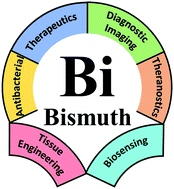当前位置:
X-MOL 学术
›
Chem. Soc. Rev.
›
论文详情
Our official English website, www.x-mol.net, welcomes your
feedback! (Note: you will need to create a separate account there.)
The versatile biomedical applications of bismuth-based nanoparticles and composites: therapeutic, diagnostic, biosensing, and regenerative properties.
Chemical Society Reviews ( IF 40.4 ) Pub Date : 2020-01-30 , DOI: 10.1039/c9cs00283a Mohammad-Ali Shahbazi 1 , Leila Faghfouri , Mónica P A Ferreira , Patrícia Figueiredo , Hajar Maleki , Farshid Sefat , Jouni Hirvonen , Hélder A Santos
Chemical Society Reviews ( IF 40.4 ) Pub Date : 2020-01-30 , DOI: 10.1039/c9cs00283a Mohammad-Ali Shahbazi 1 , Leila Faghfouri , Mónica P A Ferreira , Patrícia Figueiredo , Hajar Maleki , Farshid Sefat , Jouni Hirvonen , Hélder A Santos
Affiliation

|
Studies of nanosized forms of bismuth (Bi)-containing materials have recently expanded from optical, chemical, electronic, and engineering fields towards biomedicine, as a result of their safety, cost-effective fabrication processes, large surface area, high stability, and high versatility in terms of shape, size, and porosity. Bi, as a nontoxic and inexpensive diamagnetic heavy metal, has been used for the fabrication of various nanoparticles (NPs) with unique structural, physicochemical, and compositional features to combine various properties, such as a favourably high X-ray attenuation coefficient and near-infrared (NIR) absorbance, excellent light-to-heat conversion efficiency, and a long circulation half-life. These features have rendered bismuth-containing nanoparticles (BiNPs) with desirable performance for combined cancer therapy, photothermal and radiation therapy (RT), multimodal imaging, theranostics, drug delivery, biosensing, and tissue engineering. Bismuth oxyhalides (BiOx, where X is Cl, Br or I) and bismuth chalcogenides, including bismuth oxide, bismuth sulfide, bismuth selenide, and bismuth telluride, have been heavily investigated for therapeutic purposes. The pharmacokinetics of these BiNPs can be easily improved via the facile modification of their surfaces with biocompatible polymers and proteins, resulting in enhanced colloidal stability, extended blood circulation, and reduced toxicity. Desirable antibacterial effects, bone regeneration potential, and tumor growth suppression under NIR laser radiation are the main biomedical research areas involving BiNPs that have opened up a new paradigm for their future clinical translation. This review emphasizes the synthesis and state-of-the-art progress related to the biomedical applications of BiNPs with different structures, sizes, and compositions. Furthermore, a comprehensive discussion focusing on challenges and future opportunities is presented.
中文翻译:

铋基纳米颗粒和复合材料的多功能生物医学应用:治疗,诊断,生物传感和再生特性。
由于其安全性,高成本效益的制造工艺,大表面积,高稳定性和高可靠性,含铋材料的纳米形式的研究最近已从光学,化学,电子和工程领域扩展到生物医学领域。形状,大小和孔隙率方面的多功能性。Bi是一种无毒且廉价的抗磁性重金属,已被用于制造具有独特的结构,物理化学和组成特征的各种纳米颗粒(NP),以结合各种特性,例如有利的高X射线衰减系数和接近红外(NIR)吸收率,出色的光热转换效率和长循环半衰期。这些特征使含铋的纳米粒子(BiNPs)具有用于联合癌症治疗的理想性能,光热和放射疗法(RT),多模式成像,治疗学,药物递送,生物传感和组织工程。出于治疗目的,已经大量研究了卤氧化铋(BiOx,X为Cl,Br或I)和硫属铋化物,包括氧化铋,硫化铋,硒化铋和碲化铋。这些BiNPs的药代动力学可以通过使用生物相容性聚合物和蛋白质轻松修饰其表面来轻松改善,从而提高胶体稳定性,延长血液循环并降低毒性。在NIR激光辐射下理想的抗菌作用,骨再生潜力和肿瘤生长抑制是涉及BiNP的主要生物医学研究领域,这些领域为BiNPs的未来临床翻译开辟了新的范例。这篇综述强调了与具有不同结构,大小和组成的BiNP的生物医学应用有关的合成和最新进展。此外,还针对挑战和未来机会进行了全面讨论。
更新日期:2020-02-24
中文翻译:

铋基纳米颗粒和复合材料的多功能生物医学应用:治疗,诊断,生物传感和再生特性。
由于其安全性,高成本效益的制造工艺,大表面积,高稳定性和高可靠性,含铋材料的纳米形式的研究最近已从光学,化学,电子和工程领域扩展到生物医学领域。形状,大小和孔隙率方面的多功能性。Bi是一种无毒且廉价的抗磁性重金属,已被用于制造具有独特的结构,物理化学和组成特征的各种纳米颗粒(NP),以结合各种特性,例如有利的高X射线衰减系数和接近红外(NIR)吸收率,出色的光热转换效率和长循环半衰期。这些特征使含铋的纳米粒子(BiNPs)具有用于联合癌症治疗的理想性能,光热和放射疗法(RT),多模式成像,治疗学,药物递送,生物传感和组织工程。出于治疗目的,已经大量研究了卤氧化铋(BiOx,X为Cl,Br或I)和硫属铋化物,包括氧化铋,硫化铋,硒化铋和碲化铋。这些BiNPs的药代动力学可以通过使用生物相容性聚合物和蛋白质轻松修饰其表面来轻松改善,从而提高胶体稳定性,延长血液循环并降低毒性。在NIR激光辐射下理想的抗菌作用,骨再生潜力和肿瘤生长抑制是涉及BiNP的主要生物医学研究领域,这些领域为BiNPs的未来临床翻译开辟了新的范例。这篇综述强调了与具有不同结构,大小和组成的BiNP的生物医学应用有关的合成和最新进展。此外,还针对挑战和未来机会进行了全面讨论。











































 京公网安备 11010802027423号
京公网安备 11010802027423号